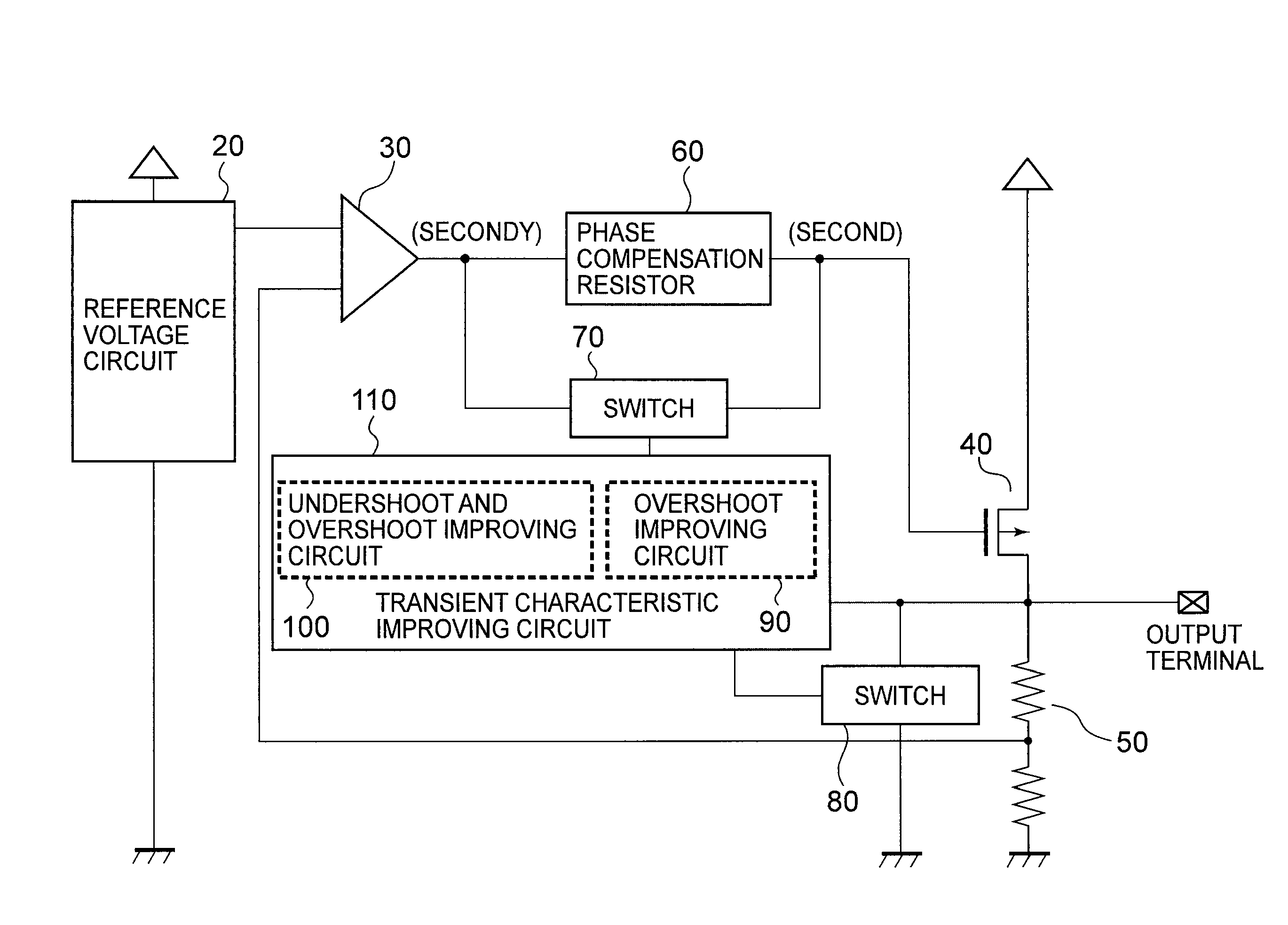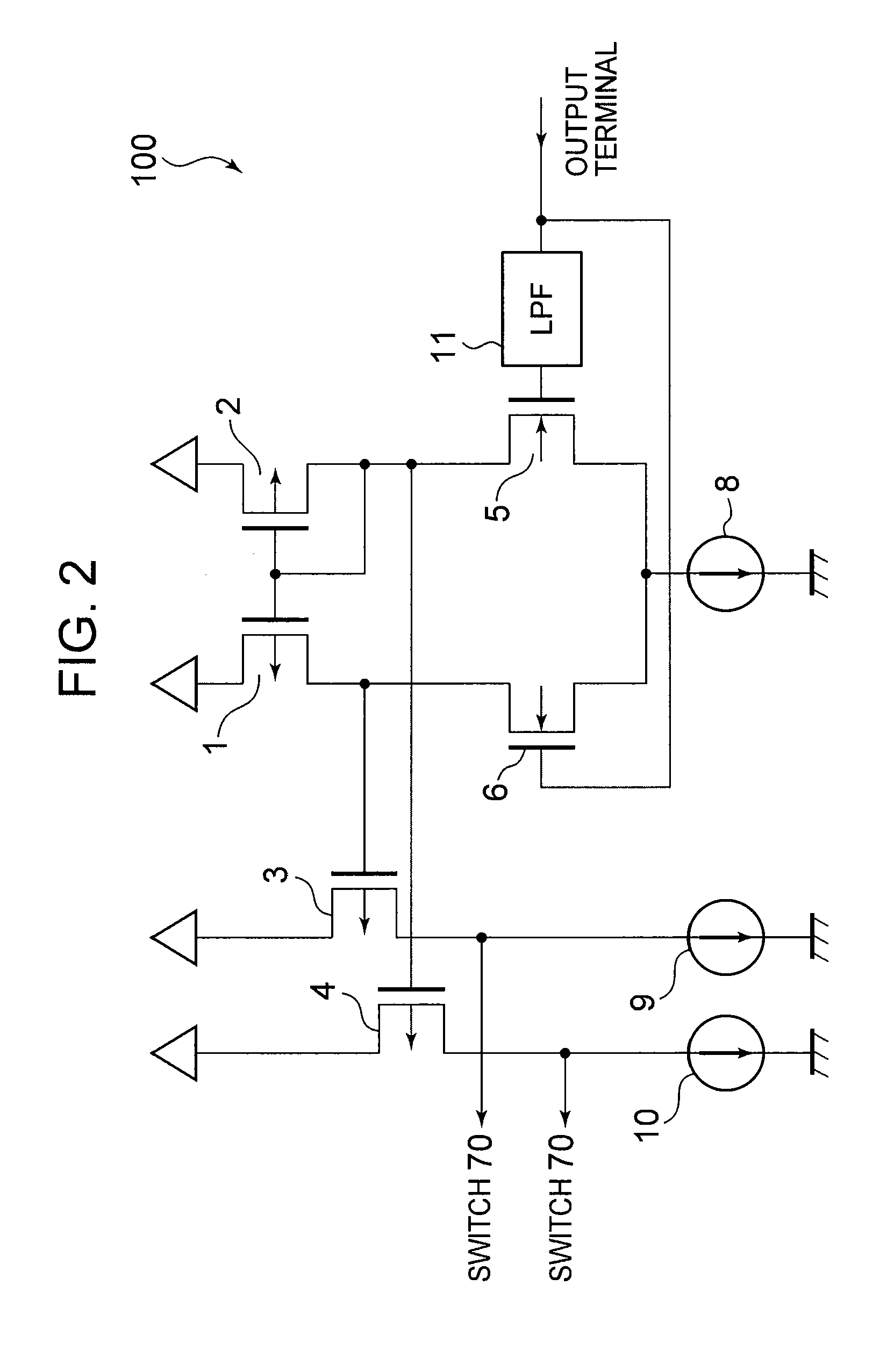Voltage regulator
a voltage regulator and transient response technology, applied in the direction of electric variable regulation, process and machine control, instruments, etc., can solve the problems of deteriorating transient response characteristic of voltage regulators and the inability to reduce consumption, so as to improve the transient response characteristic, reduce the time constant, and the effect of curren
- Summary
- Abstract
- Description
- Claims
- Application Information
AI Technical Summary
Benefits of technology
Problems solved by technology
Method used
Image
Examples
first embodiment
[0025]FIG. 1 illustrates a voltage regulator according to a first embodiment. FIG. 2 illustrates an undershoot and overshoot improving circuit 100. The undershoot and overshoot improving circuit 100 is configured to detect a fluctuation of an output voltage, and operates so as to reduce the fluctuation. Hereinafter, the configuration and operation of the undershoot and overshoot improving circuit 100 are described.
[0026]The voltage regulator includes a reference voltage circuit 20, a differential amplifier 30, an output transistor 40, a voltage divider circuit 50, a phase compensation resistor 60, a switch 70 that short-circuits the phase compensation resistor 60, and the undershoot and overshoot improving circuit 100. The undershoot and overshoot improving circuit 100 includes PMOS transistors (PMOS) 1 to 4, NMOS transistors (NMOS) 5 and 6, constant current circuits 8 to 10, and a low-pass filter (LPF) 11.
[0027]The output transistor 40 has a gate connected to an output terminal of ...
second embodiment
[0038]FIG. 3 illustrates a voltage regulator according to a second embodiment. FIG. 4 illustrates an overshoot improving circuit 90. FIG. 8 illustrates a switch 80. The reference voltage circuit 20, the differential amplifier 30, the output transistor 40, the voltage divider circuit 50, and the phase compensation resistor 60 are identical with those in the first embodiment. A difference from the first embodiment resides in that the switch 70 and the undershoot and overshoot improving circuit 100 are removed from the voltage regulator, and the switch 80 and the overshoot improving circuit 90 are inserted into the voltage regulator.
[0039]The overshoot improving circuit 90 includes PMOSs 1 to 3, NMOSs 5 and 6, constant current circuits 8 and 9, and an LPF 11. The switch 80 includes an NMOS 7.
[0040]The overshoot improving circuit 90 is connected to the output terminal of the voltage regulator, and detects an AC component of the output voltage when the output voltage fluctuates, to there...
third embodiment
[0048]FIG. 5 illustrates a voltage regulator according to a third embodiment, which has a configuration obtained by combining the first embodiment and the second embodiment. FIG. 6 illustrates a transient characteristic improving circuit 110. The reference voltage circuit 20, the differential amplifier 30, the output transistor 40, the voltage divider circuit 50, the phase compensation resistor 60, and the switch 70 are identical with those in the first embodiment. A difference from the first embodiment resides in that the undershoot and overshoot improving circuit 100 is removed from the voltage regulator, and the transient characteristic improving circuit 110 and a switch 80 are inserted into the voltage regulator.
[0049]The transient characteristic improving circuit 110 is connected to the output terminal of the voltage regulator, and detects an AC component of the output voltage when the output voltage fluctuates, to thereby control the switch 80 to short-circuit the voltage divi...
PUM
 Login to View More
Login to View More Abstract
Description
Claims
Application Information
 Login to View More
Login to View More - R&D
- Intellectual Property
- Life Sciences
- Materials
- Tech Scout
- Unparalleled Data Quality
- Higher Quality Content
- 60% Fewer Hallucinations
Browse by: Latest US Patents, China's latest patents, Technical Efficacy Thesaurus, Application Domain, Technology Topic, Popular Technical Reports.
© 2025 PatSnap. All rights reserved.Legal|Privacy policy|Modern Slavery Act Transparency Statement|Sitemap|About US| Contact US: help@patsnap.com



